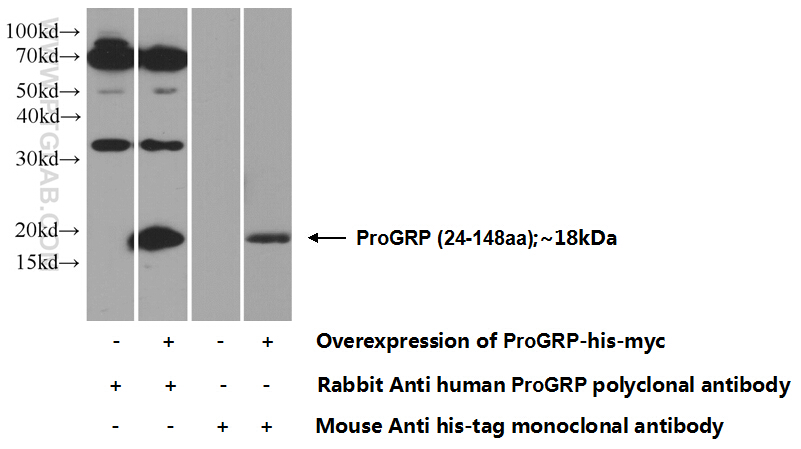验证数据展示
发表文章中的应用
| IHC | See 1 publications below |
产品信息
14646-1-AP targets ProGRP in IHC, ELISA applications and shows reactivity with human samples.
| 经测试应用 | ELISA Application Description |
| 文献引用应用 | IHC |
| 经测试反应性 | human |
| 文献引用反应性 | chimpanzee |
| 免疫原 | ProGRP fusion protein Ag6239 种属同源性预测 |
| 宿主/亚型 | Rabbit / IgG |
| 抗体类别 | Polyclonal |
| 产品类型 | Antibody |
| 全称 | gastrin-releasing peptide |
| 别名 | BN, gastrin releasing peptide, GRP, GRP 10, preproGRP, proGRP |
| 计算分子量 | 16 kDa |
| GenBank蛋白编号 | BC004488 |
| 基因名称 | GRP |
| Gene ID (NCBI) | 2922 |
| 偶联类型 | Unconjugated |
| 形式 | Liquid |
| 纯化方式 | Antigen affinity purification |
| UNIPROT ID | P07492 |
| 储存缓冲液 | PBS with 0.02% sodium azide and 50% glycerol , pH 7.3 |
| 储存条件 | Store at -20°C. Stable for one year after shipment. Aliquoting is unnecessary for -20oC storage. |
背景介绍
Gastrin-releasing peptide, also known as GRP, is normally formed by mucosal cells in the gastric antrum and by the D cells of the pancreatic islets, and its main function is to stimulate secretion of HCl by the gastric mucosa. HCl, in turn, inhibits gastrin formation. Its 148-amino acid preproprotein, following cleavage of a signal peptide, is further processed to produce either the 27-amino acid gastrin-releasing peptide or the 10-amino acid neuromedin C. These smaller peptides regulate numerous functions of the gastrointestinal and central nervous systems, including release of gastrointestinal hormones, smooth muscle cell contraction, and epithelial cell proliferation.These peptides are also likely to play a role in human cancers of the lung, colon, stomach, pancreas, breast, and prostate.
